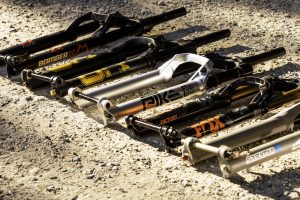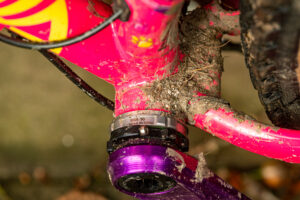Whyte's latest E-160 is packed with improvements over its predecessor, but still delivers an oh-so-sweet ride.
Whyte E-160 RSX electric mountain bike review
When we tested the Whyte E-160 back in 2021, our only real criticism of the bike was how fiddly it was to remove the battery. Fast forward to today, and Whyte has one of the easiest battery removal systems we’ve used. On the V2 bike you simply remove the single hex bolt that secures the plastic motor cover, then pop the release catch on the 750Wh Bosch battery and it pulls straight out. No wires to tangle up in and no key, other than a hex key, to remember. So how does it perform and is it one of the best electric bikes on offer?
Need to know:
- Shape.it Link has a flip-chip in the shock eyelet to provide low and lower geometry settings
- Clocking the Bosch Performance Line CX motor gets the 750Wh battery lower in the frame
- With a 36t chainring and 10-50t cassette the Whyte isn’t geared for climbing
- First gen SRAM GX AXS wireless shifting is rapid with a superlight action

The latest version also rolls on 29in wheels, instead of 27.5in, and the weight has crept by just over 1 kg to 26.17kg. Remarkably, the chainstay length has only increased by 3mm, an additional benefit of having the Bosch Performance Line CX clocked out of the way.
As you’d expect the alloy frame is bomber solid and undoubtedly contributes to the E-160’s payload. Yes, if you were to jedison the Maxxis Double Down casing rear tyre it would sneak in just under 26kg, but it’s never going to build up as light as the full carbon Specialized or Mondraker. And while Whyte’s sizing dimensions are generous, the size L sporting a 482mm reach, the range of sizing is not, the E-160 RSX only offered in M, L and XL options.

Whyte now includes the Shape.It Link in the build, which is a handy addition, because you can lower and slacken the E-160 for pure gravity fueled riding, or run it in the high position, as we did, for more technical climbing, or for improved pedal clearance on rolling terrain.
Suspension
Money saved by not having to splurge on a fancy carbon frame has wisely been invested in quality suspension components.

The E-160 RSX benefits from the added adjustability of the Performance Elite level Fox 38 fork and corresponding Float X shock.
Travel is 160mm up front combined with 150mm on the rear and while the E-160 has great poise and stability in rough terrain, is not the plushest bike in test, and not as plush or as planted as the V1.
Components
SRAM’s wireless GX AXS shifting may seem like a luxury item on an alloy bike, but the speed of the shifting really comes into its own when the contours tighten up rapidly, as it offers fast, precise, effortless shifting every time.

The same can be said for the top-end Code RSC brakes, but again the flagship brakes offer vastly superior stopping performance when compared to the Codes RS brakes on the Specialized.

And while Whyte’s choice of Maxxis tyre compounds and casings, Maxx Grip front, Double Down rear, don’t do it any favours at the weigh in and reduce the overall range of the 750Wh battery, they do reflect the bike’s intentions perfectly.
Performance
Most e-bikes are designed to let riders pedal absolutely everywhere, regardless of the terrain. Not the Whyte E-160 RSX. With the low-slung 338mm BB height timing your pedal strokes in choppy terrain is of critical importance, as you can literally feel the heel of your back foot brushing the terrain as it flies past effortlessly beneath those 29in wheels. And that’s with the flip-chip in the high position.

Factor in the punchy Bosch Performance CX motor and the ability of the E-160 to maintain speed, even on the roughest trails, and it makes going really fast as effortless as can be. Infact, speed is your friend on the Whyte E-160 as moving a 26.17kg bike around does require more input than on the 22.43kg Specialized Turbo Levo.

Given the weight, the slacker effective seat tube angle, and relatively short 445mm chainstays the E-160 wasn’t designed to KOM climbs. Instead, it is designed for bombing downhill. The combination of the low centre of gravity and long front centre mean the Whyte feels more settled when the trails are truly unsettling, where the increased weight and durability is a price many riders seeking pure downhill thrills will be happy to pay.
Looking for a great e- bike? Our guide to the best electric mountain bike will see you right, or check out our guide to the best budget eMTB for the best combination of performance and lower price.
Verdict
With rapid battery removal, a dependable build kit and fully adjustable Fox suspension components, the Whyte E-160 RSX is a great choice for anyone interested in e-bike enduro racing. In fact, the faster, steeper and rougher the terrain gets, the better the E-160 performs. You need to be a stronger rider to muscle the E-160 around though, so if pure speed isn’t the end point, the Trek Rail 9.7 offers a lighter more dynamic ride with similar geometry and poise for the same money, even if the specification isn’t on par with the Whyte E-160 RSX.
















